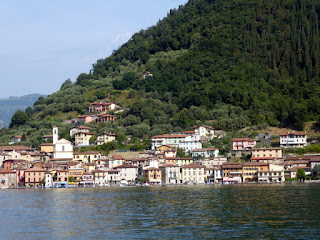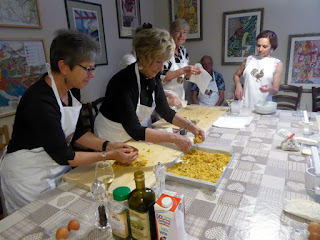We visited a large island in Lago d'Iseo today, sort of like going to Angel Island if it had a population of 1000 in 7 little villages. We were told the island was 5 miles around, like Angel Island, but it seemed bigger. When we looked it up, Wikipedia says it is 5 square miles, much bigger than Angel Island and 6 miles around. It is also almost 3 times as tall as Angel Island. It was about a 5-10 minute ferry ride each way. Cars on the island are limited to municipal vehicles, making bikes, motor scooters, feet, and buses (we saw no buses) the primary transports.
 |
Davide started the day off right with a snack
to energize us for the day. |
 |
Above/Below: In June, 2016, Christo did an installation on
the island that included a floating pier to the island and
between two other points on the island. It lasted about
two weeks and there are reminders about it all over the place. |
 |
| This is similar to our ferry |
 |
| A fortress on the near side of the island. |
The primary industry there for years was fishing and net making. Girls started to learn how to make nets at age 5 or 6 and they might continue this work even after marriage and children. With the advent of mechanically made fishing nets, the market declined, but there is still a role for soccer nets and volleyball nets and smaller scale nets for purses and totes. When we visited a net shop, a youngish man was using a sewing machine to add a thin rope edging to a very large net. I thought about buying a bottle carrier net, and should have gotten it then because the shop was closed when we came back to the ferry.
 |
Sardines are (or were) a major catch here. These are ceramic
ones, mimicking the old drying racks. |
 |
Different net products: chair, hammock, bags
and the huge one on the floor. |
 |
These trees are a type of cypress that can grow IN the water,
which is fairly high now. Lake level is controlled for hydro
power. |



Then we visited a kindergarten (really more of a preschool for ages 2 - 5) which was funded by a large donation in 1907 and finally built 30 years later. There are about 50 students on the island in grades 1 to 8, and a kindergarten on each side of the island with only about 8 or 9 children each. The kindergartens are self-funded, and this one was preparing for a fund-raiser tomorrow. Their pride and joy is a group of 5 platforms based on the 5 senses with a number of activities for each to highlight the different ways we interact with the world. My favorite was the food pyramid. After learning what you should and shouldn't eat a lot of, kids got to pick their favorite foods from a basket and then see where they were on the pyramid. Then there was a matching 'tummy' to put under the shirt, depending on which level you picked -- a really fat one for the top level and a much skinnier one for the bottom level. They have visitors from other schools who use this as a teaching tool.


 |
This is the hearing section -- the principal is holding
blindfolds |
 |
| The food ladder with the fat to thin tummies on the left |
 |
The principal learned to make nets as a child, but her mother
insisted she learn Italian instead of just the local dialect so
that she would have more options in life. The stone on the
table is a key part of net making and passed down through
the generations. This one belonged to her mother and
grand-mother and perhaps went back further. |

We had thought we would try to walk around the island, but only had about 2 hours left for the walk, sight-seeing, and lunch before the ferry back. We set out with the idea of taking a short side trip to an old private fortress above the villages, and by the time we finished, we realized the rest of the way around was out of reach so we retraced our steps back to the first village where I got a magnum bar for lunch and Jim got a raspberry spritz. In the process of trying to move my chair closer to the table where 3 of our compatriots were sitting, I managed to bump it and caused Sheila to lose part of her beverage which ended up in my lap and Jim's pants. Laundry was a main order of business when we got back to the room!
 |
| Above/below: the fortress we walked to |
 |
There was a cat colony here with a bunch of cats and
houses for them. |
 |
| Isola di San Paolo. Apparently a private residence. |
 |
| Stones for making olive oil |
Back at the hotel, we did our emergency hand laundry and started to pack for the trip to Verona. This was complicated by the two bottles of sparkling wine we bought and the need to make them fit safely in the luggage. It looks like we have about 5 pounds to spare in each bag, which is good news.
We drove south to Rovato to a cooking school and restaurant to learn to make three dishes in what was described as the old fashioned way. The recipes were also old and no mixing or forming tools were used other than our hands and a potato ricer. We broke up into groups of 4 and worked on one of three dishes: a crumble cake dessert (with almost a pound of butter for 4 theoretical servings), thin slices of raw turkey stuffed with a bread and parsley mixture, and gnocchi. It was great fun, and then we got to eat it and discovered it was delicious!
 |
This is an old building with a very old sign, which says
"Trattoria de Gallo", which is still the name of the
restaurant. |
 |
| Davide with our instructor |
 |
The building with the arch is one of the
oldest in this old section. It dates from the 1400s. |
 |
Above/below: Carol and Sheila mix the dough
by hand being careful not to press it together
so that it goes into the pan crumbly. |
 |
Jill, me, Paulette and Odell got to make the bread filling
and then wrap it into the raw turkey slices. |
 |
| Mixing the egg, bread, flour, and parsley |
 |
| Forming the filling into rolls |
 |
The finished product goes into the pan with olive oil and
maybe basil leaves. |
 |
Richard, Diane, Chuck, and Jim get directions for the potatoes,
which have been boiled and cooled. |
 |
A new experience: peeling a potato with a
butter knife. |
 |
Every one got a chance at the ricer and discovered that
small batches were much easier to squish. |
 |
The riced potatoes were mixed with flour and other ingredients
and combined by hand. They were made into big rounds,
then cut into sections and handed out to everyone to roll
into even "snakes" and cut into small pieces (below). |
 |
On our way back after our delicious dinner, we drove
around a roundabout twice for better photography of
the central sculpture. |













































No comments:
Post a Comment